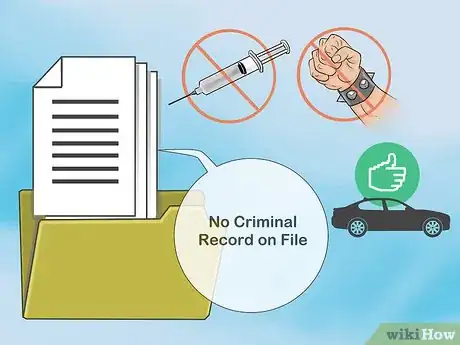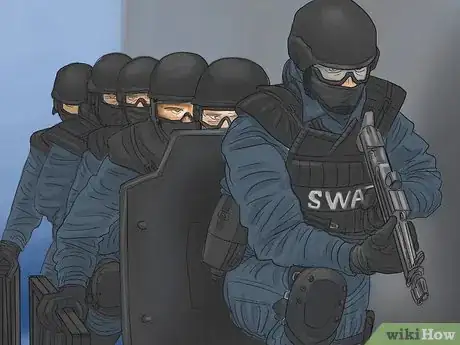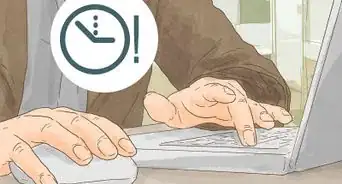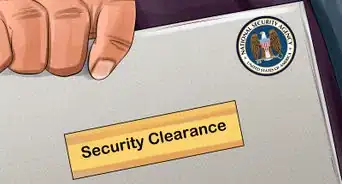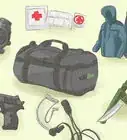This article was co-authored by wikiHow Staff. Our trained team of editors and researchers validate articles for accuracy and comprehensiveness. wikiHow's Content Management Team carefully monitors the work from our editorial staff to ensure that each article is backed by trusted research and meets our high quality standards.
wikiHow marks an article as reader-approved once it receives enough positive feedback. In this case, 92% of readers who voted found the article helpful, earning it our reader-approved status.
This article has been viewed 206,400 times.
Learn more...
Special Weapons and Tactics, or SWAT teams, are a small force of specialists within larger police departments and other law enforcement agencies. Prerequisites and processes for joining them vary from place to place; to join a specific organization’s SWAT team, contact that organization for their exact requirements and hiring procedures. However, you generally need to already be an active officer or agent within that organization to be considered.
Steps
Improving Your Chances of Being Hired as a Police Officer
-
1Keep your record clean. Show that you would be an ideal candidate for law enforcement by following the law in your daily life. Refrain from drug use and abusing other substances. Steer clear of joining any gangs. Don’t participate in criminal behavior. Drive responsibly.[1]
- If you’ve ever been convicted of a felony, your application will be rejected immediately. Misdemeanors, however, will be weighed individually. Still, the less you have, the better.[2]
-
2Earn a degree. Enroll in a community college or larger university. Obtain an associate’s or bachelor’s degree in a field that’s relevant to police work, such as criminal justice. Stand out from other candidates by proving a prior long-term commitment to becoming a police officer. Improve your chances for earning higher pay once you’re hired by earning college credits before you apply.[3]
- Each SWAT team is often divided into specialists, such as medics and negotiators.[4] Pursing academic fields related to these specialties would also be advantageous.
Advertisement -
3Train with firearms. If you have no experience with guns, visit a gun range staffed by ex-military or police personnel. Learn the correct stance to assume when firing weapons. Practice your marksmanship regularly. Research the specific weapons used by SWAT teams that you wish to join and familiarize yourself with them thoroughly, including how to load quickly, unload safely, and clean them.
- For example, the FBI arms their SWAT team members with a Heckler & Koch MP5 sub-machine gun as well as a Springfield .45 caliber pistol.
-
4Exercise regularly. Expect to face a rigorous physical fitness test as part of the hiring process to become a police officer and then again to become a SWAT team member.[5] [6] Focus on developing your speed, endurance, and agility. Work out daily, without fail, if only for a half-hour if that’s all you can afford. Include stretching as part of your routine to maintain and improve flexibility.[7]
-
5Attend a police academy. The exact structure and length of your training will vary by academy, but expect an intense and extensive curriculum, including but not limited to: self-defense; firearms; pursuit driving; ethics; law; policies and procedures; human relations; stress management. Get a taste of the high-pressure situations you might face as an officer by completing all this in as little as six months. Expect high standards from your instructors and a high drop-out rate from your fellow cadets.[8]
- Attending a police academy is mandatory to become an officer. Many police departments run their own academies, which you will join as the last step in the hiring process. However, the smaller the department, the more likely they’ll require you to have completed training by a certified academy instead before you even apply for the job. In either case, it’s a good idea to join an academy before seeking employment, since it will look favorable on your application and better prepare you for a second go if necessary.
-
6Be willing to move. Since most police agencies only accept applications when they have a specific opening to fill, expand your job search beyond your current residence. If you’re interested in joining a particular police department, check their website’s recruitment page regularly so you can apply immediately. In the meantime, follow websites that share current job postings in law enforcement nationwide.[9] Include urban areas in your job search, since they typically have large police forces with more vacancies to fill. Useful websites include:
- www.discoverpolicing.org
- www.policeone.com
- www.policecareerfinder.com
Becoming a Police Officer
-
1Fill out an application. If the recruitment page on the department’s website offers an online application, complete it there. Otherwise, contact the department to find out how to apply, since the process varies. Some may ask you to complete an application before doing anything else. Others may have you fill one out and take the entrance exam on the same day. Either way, set aside plenty of time to fill out the application, since it is far longer than most.[10]
- Fill your application out honestly, since a very extensive background check will ensue. You may also have to submit to a polygraph test later on.
- To apply, you generally need to be at least 21 years old, a U.S. citizen, and a high school graduate.
-
2Take the entrance exam. Study beforehand for the civil service exam. Expect sections that will test job-specific skills, such as your ability to read maps, write reports, and accurately recall in detail observations that you’ve made. Also concentrate on sections that test your verbal skills, since these are arguably one of the most important skills for a police officer to have, whether they’re interacting with citizens, communicating information in a crisis, or testifying in court.[11]
-
3Complete the physical fitness test. Expect your speed, endurance, and agility to be challenged. Tests vary from one department to another, but prepare to run either a short distance with maximum speed, a long distance at a consistent pace, or both. Perform simulations of real-life possibilities, such as climbing, moving a dummy/body, completing an obstacle course, or pushing a car.[12]
- Depending on the department, physical fitness tests may be administered on the same day as your entrance exam.
-
4Face the oral board. Answer questions presented by police officers in an interview-setting. Expect questions that are normal to job interviews (such as “Why are you interested in this job?”) as well as questions designed to test your ability to remain composed in a high-pressure situation. Answer all questions truthfully. Remain calm. Prove both your honesty and your ability to keep a level head under intense scrutiny.[13]
- Since the oral board may come after the background check, any discrepancies between its results and your job application may come to light now. If you were trying to hide any misdemeanors or such from your past, confess to them now, since your honesty is also being evaluated.
- Remember the Kobayashi Maru from Star Trek. There is often no correct answer to the question you’ve been asked. The focus here is primarily to see how you handle yourself in uncertainty.
-
5Submit to psychological and physical examinations. For the psychological test, complete a written test and be interviewed by a psychologist assigned by the department. For the physical test, provide blood and urine samples for testing. Submit to a physical. Depending on the department’s resources, this may be a standard procedure on par with those performed for eligibility in high school sports, or they may be more extensive, incorporating more high-tech tests.[14]
-
6Complete the executive interview. Face further questioning by even higher ranking officers than those on the oral board. Be confident in that you’ve made it this far, since so many other candidates will have been eliminated by now. However, this is your last opportunity to convince them that you are the most ideal candidate, so present your best self.[15]
-
7Attend the academy and train in the field. If your department requires you to attend its own police academy after the hiring process, complete the course. Afterward, begin training with a field training officer. Receive verbal instruction and modeled behavior from the FTO before entering the field. Then observe the FTO in action in the field. Expect this period to last anywhere from three to twelve months before receiving the FTO’s endorsement for you to become a full-time officer in your own right.[16]
Becoming a SWAT member
-
1Be an exemplary cop. Prove yourself to be an ideal candidate for this elite force by performing your current duties with absolute professionalism.[17] Follow policies and procedures exactly. Make sound decisions in the field. Demonstrate your ability to work as a team by building trust with your fellow officers.
- Although the length of required service varies from department to department, most if not all SWAT teams hire from within. Expect to serve as a regular police officer for at least two to three years before becoming eligible.[18]
-
2Keep an eye out for openings. Express your interest in joining the SWAT team to your superiors early on. Ask them for a recommendation and to keep you informed of any developments. Check with human resources regularly for new postings. Since the SWAT team is such a small force, expect competition for each opening.[19]
-
3Apply to become a SWAT member. Undergo a vetting process similar to the one you faced when you applied to become a regular police officer. While the exact process will vary from one department to another, expect to begin with a basic training course designed to see if you meet the minimum requirements to join the SWAT team. Basic training will most likely include:
- Written exams testing your knowledge of police procedure.
- Psychological exams testing your capacity to handle crisis and high-stress situations.
- Physical training and evaluations designed to enhance your individual skills and incorporate them into a team environment, with the emphasis on physical fitness, obstacle courses, and proficiency with handguns and shotguns.
-
4Advance to higher-level training. Upon completion of basic training, graduate to the next tier of testing. Further hone the same skills tested in basic training. Focus even more on the ability to work as one part of a synchronized team. Learn tactics specific to scenarios that you will likely face as a SWAT member, such as safely and effectively entering and clearing a room and coordinating movement as a unit through obstacle courses.
-
5Complete arms training. Become proficient with SWAT-issued weaponry. Learn to break down and clean each one properly. Perfect your marksmanship with each one by means of iron sights, optics, and night-vision devices. If not these specific weapons, expect to use firearms similar to:
- Colt M-4
- Heckler & Koch 416
- Sig-Sauer 552P
- Heckler & Koch MP-5N
-
6Undergo specialty training. Depending on your department, this step may begin and/or continue indefinitely after you’ve been officially accepted to the SWAT team. Continue to develop specialized skills to better handle situations unique to your assignment. These may include but are not limited to:
- Handling hazardous materials
- Providing medical assistance
- Navigating with compasses and GPS technology
- Executing air- and water-based operations
- Breaching doors and other entry points
- Engaging in covert operations
- Sniping
- Planning tactical operations
Community Q&A
-
QuestionDo I need to face any pain tests?
 Community AnswerLike in some police departments, you may have to get tasered before you can join. This is so you do not abuse your taser.
Community AnswerLike in some police departments, you may have to get tasered before you can join. This is so you do not abuse your taser. -
QuestionDo you have to get tased to become a SWAT officer?
 Community AnswerSome police departments include tasing in basic training for regular police officers, so it is possible that you might face this again in SWAT training.
Community AnswerSome police departments include tasing in basic training for regular police officers, so it is possible that you might face this again in SWAT training. -
QuestionIs joining the military police a good way to get some experience if I want to join a SWAT team?
 Community AnswerYes, it will help a lot, especially if you get training in long arms (assault rifles, carbines, SMG) and policing.
Community AnswerYes, it will help a lot, especially if you get training in long arms (assault rifles, carbines, SMG) and policing.
Warnings
- Becoming a SWAT team member is a lengthy process. Becoming a regular police officer may take up to 12 to 18 months; you will have to serve for at least a couple years before being considered for the SWAT team’s hiring process.[21]⧼thumbs_response⧽
References
- ↑ http://www.how-to-become-a-police-officer.com
- ↑ http://www.criminaljusticeusa.com/police-officer/
- ↑ http://www.how-to-become-a-police-officer.com/
- ↑ http://www.innerbody.com/careers-in-criminal-justice/how-to-become-a-swat-officer.html
- ↑ http://www.how-to-become-a-police-officer.com
- ↑ http://www.policemag.com/channel/swat/articles/2006/11/how-to-get-into-swat-shape/page/2.aspx
- ↑ http://www.policemag.com/channel/swat/articles/2006/11/how-to-get-into-swat-shape/page/2.aspx
- ↑ http://www.how-to-become-a-police-officer.com
- ↑ http://www.how-to-become-a-police-officer.com
- ↑ http://www.how-to-become-a-police-officer.com
- ↑ http://www.how-to-become-a-police-officer.com
- ↑ http://www.how-to-become-a-police-officer.com
- ↑ http://www.how-to-become-a-police-officer.com
- ↑ http://www.how-to-become-a-police-officer.com
- ↑ http://www.how-to-become-a-police-officer.com
- ↑ http://www.how-to-become-a-police-officer.com
- ↑ http://www.innerbody.com/careers-in-criminal-justice/how-to-become-a-swat-officer.html
- ↑ http://www.fbiagentedu.org/careers/tactical-operations/fbi-swat/
- ↑ http://www.innerbody.com/careers-in-criminal-justice/how-to-become-a-swat-officer.html
- ↑ http://www.innerbody.com/careers-in-criminal-justice/how-to-become-a-swat-officer.html
- ↑ http://www.criminaljusticeusa.com/police-officer/
About This Article
To join the SWAT team, start by earning an associate’s or bachelor’s degree in a field that is relevant to police work, such as criminal justice. Next, attend police academy so that you can get the education and experience you need to become a police officer. Then, prove yourself to be an ideal candidate for the SWAT team by being an excellent cop. Finally, apply for an open SWAT team position and undergo the required vetting process to start your specialty training and join the team! For tips on preparing for police academy, read on!
